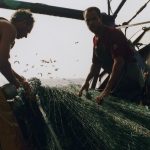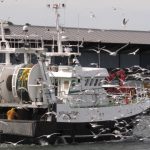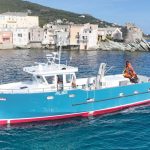The Karstensens yard’s latest delivery is a 70m pelagic vessel for Fraserburgh owners with a history going back more than a century. Grateful FR-249 replaces the 64 metre Forever Grateful, which was sold in 2016 and is now fishing as Trygvason for its Norwegian owners.
The new pelagic vessel’s steelwork was completed at the Nauta Shipyard in Gdansk, after which it was towed to Skagen at the end of last year to be fitted out by Karstensens Skibsværft.
Owners Eschol Fishing is the Whyte family, with the third generation now in charge as William (Sr) and Andrew Whyte who have been in charge for three decades take a step back. The origins of the business go back to their grandfather who ran an inshore vessel, Excelsior FR-887 in the early years of the 20th century.
Today William (Jr), Nathan and Aaron Whyte with their brother-in-law Derek Cardno run the company, with all of them members of the new Grateful’s regular crew.
‘The owners and the yard have a longstanding relationship,’ said Kent Damgaard at Karstensens. ‘William (Sr) and Andrew were the first to take a Scottish fishing vessel to the Karstensen Shipyard for a major refit back in 1983.’
He added that the design, R03;specification and arrangements are a result of an extensive and close co-operation between owners and yard.
‘The main focus has been set on optimising working, safety and comfort for the crew, catch handling- and storage facilities, and fuel consumption. Among other things, Grateful will be the first fishing vessel in the Scottish fleet with a retractable thruster, supplied by Brunvoll. This thruster can work as a drop-down Azimuth, functioning as a take-me-home device, or even used during slow steaming, dodging or stern pumping.’
Grateful’s dimensions are a 69.95 metre overall length, with a moulded breadth of 15 metres, a carrying capacity of 2033m3 in the eleven RSW tanks, and accommodation for a crew of 16 in single and twin cabins.
Deck equipment is from Rapp Hydema, with a pair of 90 tonne trawl winches, a 73 tonne topline winch, a 46.70 tonne tail-end winch and a pair of 92.60 tonne net drums in a waterfall configuration. also part of the package are a netsounder winch, a hydraulic hose reel and a fish hose reel, as well as mooring and anchor windlasses.
Rapp Marine also supplied the high-pressure hydraulic systems with 6x160kW, 3x108kW and one 120kW pump units. Sea Quest supplied the pair of 24 inch fish pumps, the 4tx18m foredeck crane and the pair of 4tx14m fish pump and net cranes located aft.
The twin RSW systems are 1345 kW / 1.156.000 kCal/h sets from Johnson Controls (York/Sabroe), with two 950m3/h circulation pumps, two 300m3/h condenser pumps remote operated RSW-valves via the Johnson Controls control system. The vacuum system is from C-Flow and comprises four 66kW compressor units and two 4200 litre tanks.
Grateful’s main engine is a 4500kW MaK 9M32C driving a Scana Volda CP95/4, 4200mm propeller via a Scana Volda ACG-850/PS680 two-speed reduction gear to provide 130/105 propeller revolutions.
The reduction gearbox is fitted with PTO mounted with a shaft alternator to produce 2500 kWe, and additional electrical power comes from the two Mitsubishi S12A2-MPTAW, 820 kWe generators and the S6R-Z3 MPTAW, 580 kWe harbour set. During hauling and shooting with the winch system in use, the gearbox PTO is clutched in and the ship’s electric power is sourced from the shaft generator.
This works on the premise that with full power routed to the winches, there is no high demand for propulsion power from the main engine, so it follows that the main engine is the primary power source for both propulsion and winches. During towing, the shaft alternator can be disengaged from the switchboard, and the electrical power is supplied by either of the gensets. These are able to connect into main switchboard, controlled by the vessel’s DEIF power management system. A bus-bar breaker is fitted on main switchboard, allowing the aft 950kW Brunvoll thruster to be fed off shaft alternator and 850kW forward retractable combi thruster and vessel’s other power requirements to be met by the generator sets.
The electrical power system is fitted for sliding a frequency (60-50 Hz) with frequency converters for 400/440 V and a static converter/UPS for stable 230 V supply. This allows main engine and propeller revolutions to be reduced with 17%, contributing to Grateful’s economic operation.





